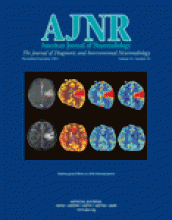Abstract
Summary: The basilar artery as the origin of the ophthalmic artery is extremely rare. A 48-year-old patient had undergone angiography for suspicion of a right middle cerebral artery aneurysm. No aneurysm was detected. Vertebral artery injections demonstrated the left ophthalmic artery originating from the basilar trunk. Current embryologic theories fall short in explaining this entity. Awareness of neuroanatomic variations is of paramount importance in diagnosis and treatment of vascular lesions of the brain.
The ophthalmic artery (OA) is the first major branch of the supraclinoid internal carotid artery (ICA) (1). Although rare, middle meningeal artery (MMA) (2, 3), anterior cerebral artery (ACA) (4, 5), and ICA bifurcation (6) have been shown as variants of origin for the OA. The basilar artery (BA) has been described only once previously in this context and was associated with an orbital arteriovenous malformation (AVM) (7). To the best of our knowledge, the case presented here is the first report describing BA as the origin of OA in the absence of a vascular malformation.
Case Report
A 48-year-old woman was initially evaluated elsewhere for nonspecific symptoms. She was referred to our clinic after MR imaging findings raised suspicion of an incidental right middle cerebral artery (MCA) aneurysm. Her neurologic examination was completely normal. Findings of four-vessel digital subtraction angiography was consistent with an ectasia of the right MCA trifurcation and did not show any aneurysmal formation; however, the left OA, originating from the basilar trunk, was visualized after injection of the vertebral arteries (Fig 1). No anastomosis of OA with any other vascular structure was detected during its intracranial course. Ipsilateral ICA and posterior communicating artery were patent. The patient was managed conservatively and is currently under follow-up.
Lateral projection of the left vertebral artery injection. A, Ophthalmic artery originates from the basilar trunk just proximal to the level of the superior cerebellar artery origin and courses anteriorly during the arterial phase (arrow). The posterior communicating artery is patent (chevron). B, Ophthalmic artery enters the orbita (arrow). It is still visible during the early venous phase.
Discussion
Atypical origin of the OA is a rare entity. In a study of 109 cadavers, the point of origin was on the ICA in all specimens, 59% being over or on the cavernous roof (8). It typically originates beneath the lateral aspect of the overlying optic nerve and travels through the optic canal (1).
Embryogenesis of the OA is highly complex. Vascularization of the optic cup is derived from two branches of the primitive ICA called the primitive ventral (VOA) and dorsal ophthalmic arteries (DOA). The VOA arises from the future ACA, and the DOA from the carotid siphon (9). Later, these arteries anastomose near the optic nerve. The VOA makes an additional anastomosis with the supracavernous portion of the ICA. Meanwhile, both of these primitive arteries show partial regressions: the VOA at its proximal portion and the DOA at the level of the superior orbital fissure. This final configuration gives rise to the primitive ophthalmic artery (POA) (10, 11).
When the embryo reaches 18 mm, the stapedial artery, which arises from the primitive hyoidal branch of the petrous ICA, gives rise to the maxillofacial and supraorbital branches (12). At the stage of 20 mm, the supraorbital branch anastomoses with the POA. By 40 mm, the anastomosis is complete and POA starts to assimilate the supraorbital branch. This branch not only supplies the intraorbital extraocular contents, but also carries a role in forming the MMA.
The origin of the OA from the ACA (4, 5), the ICA bifurcation (6), or double OA originating from the same ICA (9), can be explained with relative ease by the stages before the formation of the POA. Similarly, the OA arising from the MMA, which is the most frequently reported variation (2), the MMA arising from the OA (12) and persistent loop of the ICA, MMA, and OA (13), can be explained by the role of the stapedial artery.
Unfortunately, the classic embryologic knowledge does not explain the basilar origin of the OA. Although the primitive trigeminal artery (PTA), which connects the proximal intracavernous portion of ICA and distal third of BA, may look like a suitable explanation, it falls short in several aspects in our case: first and most important, the ICA is not involved in this case. Second, blood generally flows from the ICA to the BA within the PTA (14). A flow from the BA to the orbit can, however, be seen in Figure 1. Also, from the embryologic point of view, the OA appears significantly later than the regression of the primitive carotidobasilar anastomotic arteries, and it is formed from several vessels instead of one primitive trunk (7). These factors make a pure PTA origin unlikely and anastomosis between the stapedial artery and the vertebrobasilar system or the PTA appears to be a more probable explanation as proposed by Schumacher and Wakhloo (7). Seeger and Hammer (15) suggested the role of a similar anastomosis between the PTA and MMA to explain the BA as the origin of the MMA.
To the best of our knowledge, the first and, so far, only report demonstrating the BA as the origin of the OA was published in this journal (7). In that report, the abnormal OA was described as one of the feeding vessels of an orbital AVM. One may speculate the role of an AVM on the development of this abnormal OA. There was, however, no coexistence of such a malformation in our case.
Conclusion
The OA arising from the BA is an extremely rare variant, and current embryologic theories do not provide satisfactory explanation for this occurrence. Awareness of rare variations in anatomic structures is of paramount importance both for diagnosis and treatment of vascular lesions of the brain.
References
- Received January 5, 2004.
- Accepted after revision February 18, 2004.
- Copyright © American Society of Neuroradiology













